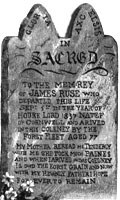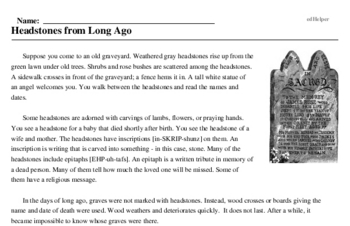Headstones from Long Ago
Plan Your Epitaph Day
Reading Comprehension for November 2
Suppose you come to an old graveyard. Weathered gray headstones rise up from the green lawn under old trees. Shrubs and rose bushes are scattered among the headstones. A sidewalk crosses in front of the graveyard; a fence hems it in. A tall white statue of an angel welcomes you. You walk between the headstones and read the names and dates.
Some headstones are adorned with carvings of lambs, flowers, or praying hands. You see a headstone for a baby that died shortly after birth. You see the headstone of a wife and mother. The headstones have inscriptions [in-SKRIP-shunz] on them. An inscription is writing that is carved into something - in this case, stone. Many of the headstones include epitaphs [EHP-uh-tafs]. An epitaph is a written tribute in memory of a dead person. Many of them tell how much the loved one will be missed. Some of them have a religious message.
In the days of long ago, graves were not marked with headstones. Instead, wood crosses or boards giving the name and date of death were used. Wood weathers and deteriorates quickly. It does not last. After a while, it became impossible to know whose graves were there.
The next material to be used for headstones was limestone. Words could be carved into limestone. Limestone headstones lasted longer than those made of wood. However, limestone does not age well. The weather wears the surface away. In time, limestone headstones become hard to read and begin to break apart.
Now granite is the stone of choice. Granite headstones last a long, long time. They are quite expensive. People don't often buy ornate headstones like the old ones that can be found in old graveyards. Headstones have become simple again.
Old headstones were often adorned with carvings. The carvings held special meanings. Here are some of the most common:
Flowers symbolize life's frailty or mortality.
Flying birds symbolize the flight of the soul.
Hands: a set of praying hands indicates the hope of the family that their loved one is in heaven.
Two hearts symbolize love in marriage.
Hourglass: the hourglass's message is that time passes quickly; life is short.




